2023 HYUNDAI IONIQ 6 air condition
[x] Cancel search: air conditionPage 87 of 582
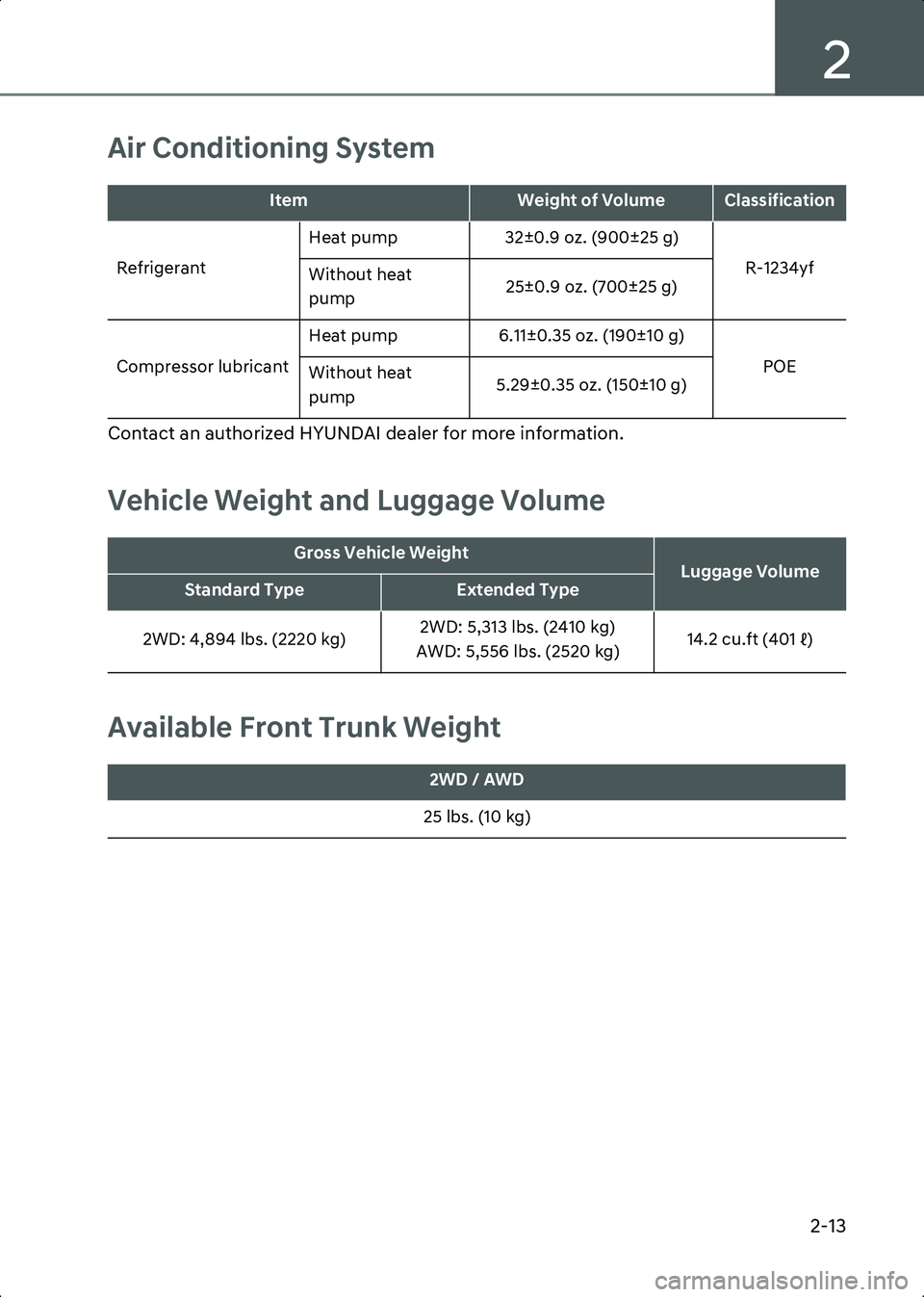
2
2-13
Air Conditioning System
Contact an authorized HYUNDAI dealer for more information.
Vehicle Weight and Luggage Volume
Available Front Trunk Weight
ItemWeight of VolumeClassification
Refrigerant Heat pump
32±0.9 oz. (900±25 g)
R-1234yf
Without heat
pump 25±0.9 oz. (700±25 g)
Compressor lubricant Heat pump
6.11±0.35 oz. (190±10 g)
POE
Without heat
pump 5.29±0.35 oz. (150±10 g)
Gross Vehicle WeightLuggage VolumeStandard TypeExtended Type
2WD: 4,894 lbs. (2220 kg) 2WD: 5,313 lbs. (2410 kg)
AWD: 5,556 lbs. (2520 kg) 14.2 cu.ft (401 ℓ)
2WD / AWD
25 lbs. (10 kg)
Hyundai_CE_en_US.book Page 13
Page 91 of 582
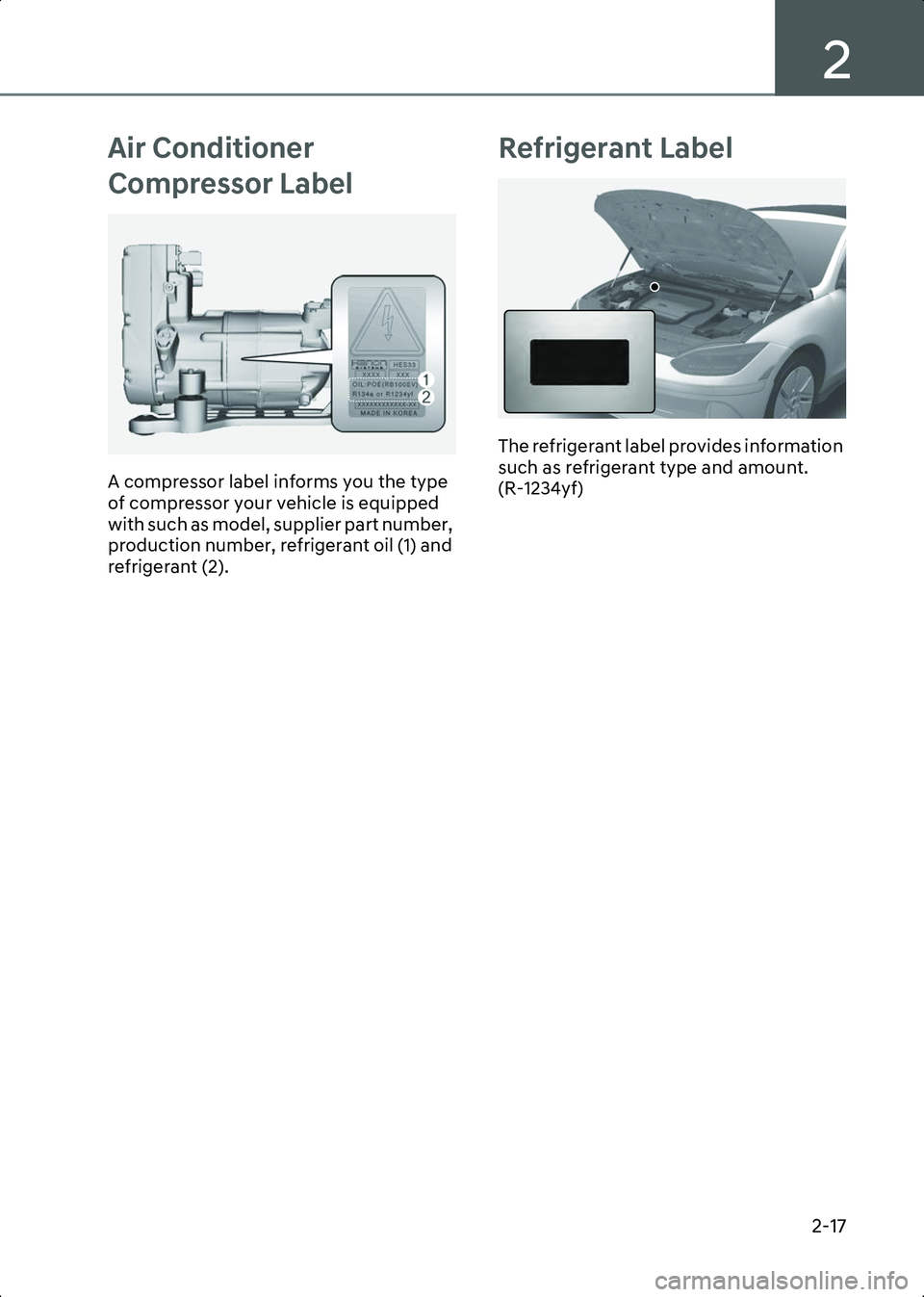
2
2-17
Air Conditioner
Compressor Label
ONE1011026L
A compressor label informs you the type
of compressor your vehicle is equipped
with such as model, supplier part number,
production number, refrigerant oil (1) and
refrigerant (2).
Refrigerant Label
B5020201
The refrigerant label provides information
such as refrigerant type and amount.
(R-1234yf)
Hyundai_CE_en_US.book Page 17
Page 95 of 582

3
3. Seats & Safety System
Important Safety Precautions......................................................................................... 3-2Always Wear Your Seat Belt ........................................................................................ 3-2Restrain All Children .................................................................................................... 3-2
Airbag Hazards ............................................................................................................. 3-2
Driver Distraction ......................................................................................................... 3-2Control Your Speed...................................................................................................... 3-2Keep Your Vehicle In Safe Condition .......................................................................... 3-2
Seats ................................................................................................................................. 3-3 Safety Precautions ....................................................................................................... 3-5
Front Seats.................................................................................................................... 3-5Rear Seats ..................................................................................................................... 3-9
Head Restraint ............................................................................................................ 3-11
Seat Warmers ..............................................................................................................3-14
Air Ventilation Seats.................................................................................................... 3-17
Seat Belts ....................................................................................................................... 3-19 Seat Belt Safety Precautions ..................................................................................... 3-19
Seat Belt Warning Light ............................................................................................. 3-20
Seat Belt Restraint System ......................................................................................... 3-21
Additional Seat Belt Safety Precautions................................................................... 3-26
Care of Seat Belts....................................................................................................... 3-27
Child Restraint System (CRS) ....................................................................................... 3-28 Children Always in the Rear ...................................................................................... 3-28Selecting a Child Restraint System (CRS) ................................................................ 3-29
Installing a Child Restraint System (CRS) ................................................................3-30
Airbag - Supplemental Restraint System..................................................................... 3-36 Where are the Airbags? ............................................................................................. 3-37
How does the Airbags System Operate?..................................................................3-40
What to Expect After an Airbag Inflates ................................................................... 3-43
Occupant Classification System (OCS) .................................................................... 3-44
Why didn’t My Airbag Go Off in a Collision? ............................................................3-50
SRS Care ..................................................................................................................... 3-54
Additional Safety Precautions ................................................................................... 3-55
Airbag Warning Labels............................................................................................... 3-55
Hyundai_CE_en_US.book Page 1
Page 96 of 582

Seats & Safety System
3-2
Important Safety
Precautions
You will find many safety precautions and
recommendations throughout this
section, and throughout this manual. The
safety precautions in this section are
among the most important.
Always Wear Your Seat Belt
A seat belt is your best protection in all
types of accidents. Airbags are designed
to supplement seat belts, not to replace
them. So even though your vehicle is
equipped with airbags, always make sure
you and your passengers wear your seat
belts, and wear them properly.
Restrain All Children
All children under age 13 should ride in
your vehicle properly restrained in a rear
seat, not the front seat. Infants and small
children should be restrained in an
appropriate child restraint system. Larger
children should use a booster seat with
the lap/shoulder belt until they can use
the seat belt properly without a booster
seat.
Airbag Hazards
While airbags can save lives, they can also
cause serious or fatal injuries to
occupants who sit too close to them, or
who are not properly restrained. Infants,
young children, and short adults are at the
greatest risk of being injured by an
inflating airbag. Follow all instructions
and warnings in this manual.
Driver Distraction
Driver distraction presents a serious and
potentially deadly danger, especially for
inexperienced drivers. Safety should be
the primary concern when behind the
wheel and drivers need to be aware of the wide array of potential distractions, such
as drowsiness, reaching for objects,
eating, personal grooming, other
passengers, and using mobile phones.
Drivers can become distracted when they
take their eyes and attention off the road
or their hands off the wheel to focus on
activities other than driving. To reduce
your risk of distraction and an accident:
• Set up your mobile devices (for
example, mp3 players, phones,
navigation units, etc.) only when your
vehicle is parked or safely stopped.
• Only use your mobile device when allowed by laws and conditions permit
safe use. Never text or email while
driving. Most countries have laws
prohibiting drivers from texting. Some
countries and cities also prohibit
drivers from using handheld phones.
• Never let the use of a mobile device distract you from driving. You have a
responsibility to your passengers and
others on the road to always drive
safely with your hands on the wheel as
well as your eyes and attention on the
road.
Control Your Speed
Excessive speed is a major factor in crash
injuries and deaths. Generally, the higher
the speed the greater the risk, but serious
injuries can also occur at lower speeds.
Never drive faster than is safe for current
conditions regardless of the maximum
speed posted.
Keep Your Vehicle In Safe
Condition
Having a tire blowout or a mechanical
failure can be extremely hazardous. To
reduce the possibility of such problems,
check your tire pressures and condition
frequently and perform all regularly
scheduled maintenance.
Hyundai_CE_en_US.book Page 2
Page 112 of 582
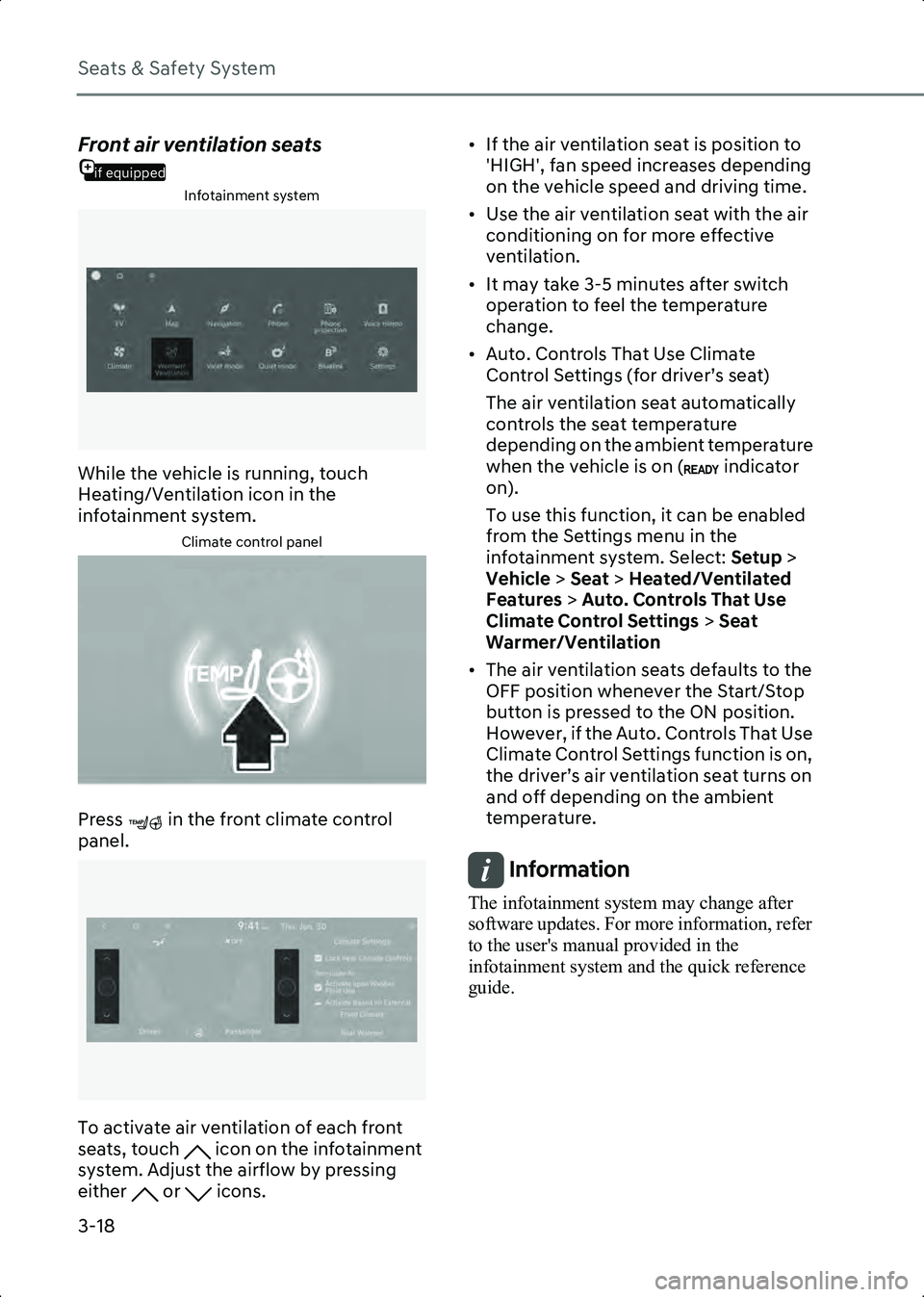
Seats & Safety System
3-18
if equipped
Front air ventilation seats
Infotainment system
ONE1031085L
While the vehicle is running, touch
Heating/Ventilation icon in the
infotainment system.
Climate control panel
B3000602
Press in the front climate control
panel.
ONE1031080L
To activate air ventilation of each front
seats, touch icon on the infotainment
system. Adjust the airflow by pressing
either or icons.• If the air ventilation seat is position to
'HIGH', fan speed increases depending
on the vehicle speed and driving time.
• Use the air ventilation seat with the air conditioning on for more effective
ventilation.
• It may take 3-5 minutes after switch operation to feel the temperature
change.
• Auto. Controls That Use Climate Control Settings (for driver’s seat)
The air ventilation seat automatically
controls the seat temperature
depending on the ambient temperature
when the vehicle is on ( indicator
on).
To use this function, it can be enabled
from the Settings menu in the
infotainment system. Select: Setup >
Vehicle > Seat > Heated/Ventilated
Features > Auto. Controls That Use
Climate Control Settings > Seat
Warmer/Ventilation
• The air ventilation seats defaults to the OFF position whenever the Start/Stop
button is pressed to the ON position.
However, if the Auto. Controls That Use
Climate Control Settings function is on,
the driver’s air ventilation seat turns on
and off depending on the ambient
temperature.
Information The infotainment system may change after
software updates. For more information, refer
to the user's manual provided in the
infotainment system and the quick reference
guide.
Hyundai_CE_en_US.book Page 18
Page 128 of 582
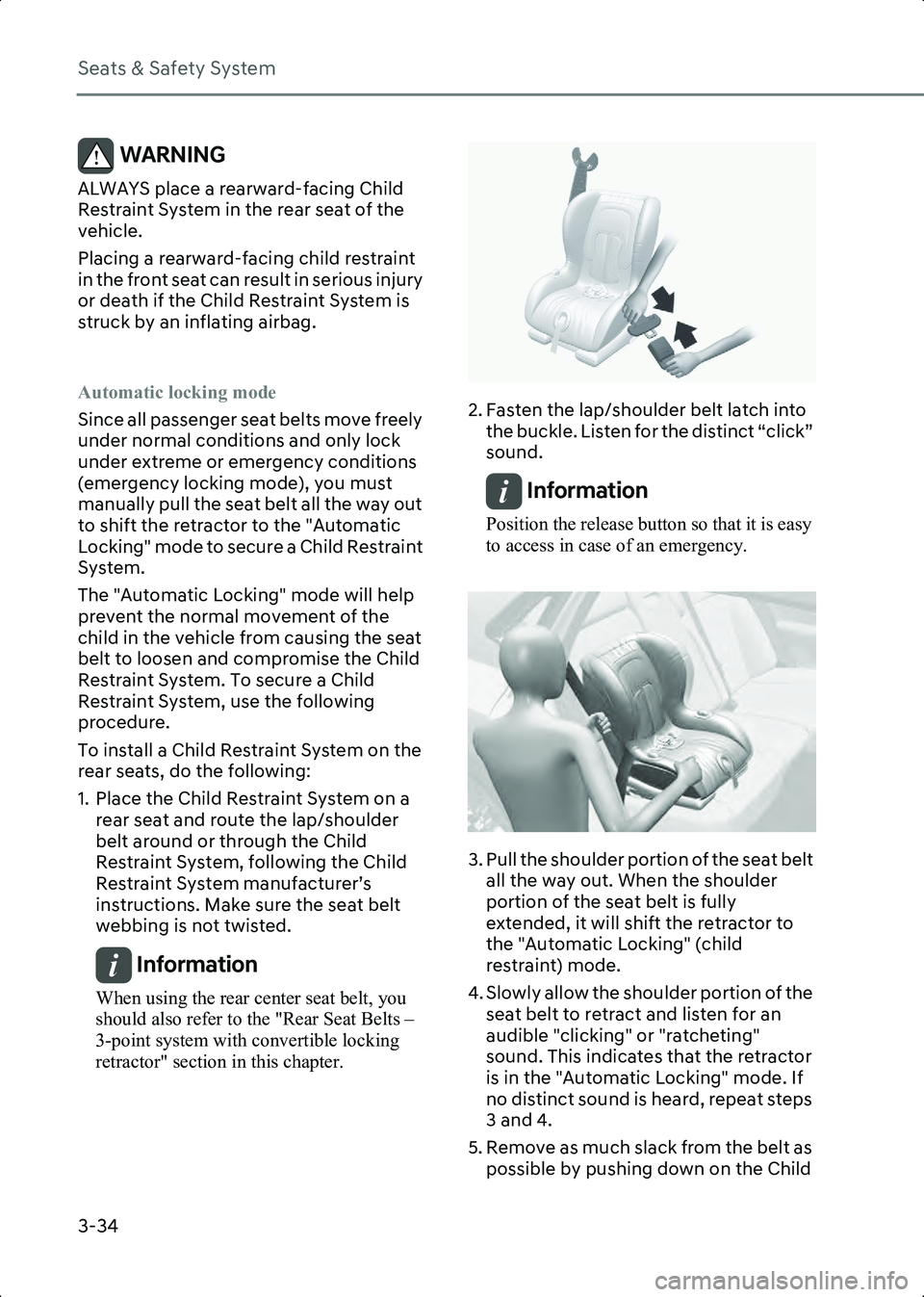
Seats & Safety System
3-34
WARNING ALWAYS place a rearward-facing Child
Restraint System in the rear seat of the
vehicle.
Placing a rearward-facing child restraint
in the front seat can result in serious injury
or death if the Child Restraint System is
struck by an inflating airbag.
Automatic locking mode
Since all passenger seat belts move freely
under normal conditions and only lock
under extreme or emergency conditions
(emergency locking mode), you must
manually pull the seat belt all the way out
to shift the retractor to the "Automatic
Locking" mode to secure a Child Restraint
System.
The "Automatic Locking" mode will help
prevent the normal movement of the
child in the vehicle from causing the seat
belt to loosen and compromise the Child
Restraint System. To secure a Child
Restraint System, use the following
procedure.
To install a Child Restraint System on the
rear seats, do the following:
1. Place the Child Restraint System on a rear seat and route the lap/shoulder
belt around or through the Child
Restraint System, following the Child
Restraint System manufacturer’s
instructions. Make sure the seat belt
webbing is not twisted.
Information When using the rear center seat belt, you
should also refer to the "Rear Seat Belts –
3-point system with convertible locking
retractor" section in this chapter.
B3002204
2. Fasten the lap/shoulder belt latch into the buckle. Listen for the distinct “click”
sound.
Information Position the release button so that it is easy
to access in case of an emergency.
B3002207
3. Pull the shoulder portion of the seat belt all the way out. When the shoulder
portion of the seat belt is fully
extended, it will shift the retractor to
the "Automatic Locking" (child
restraint) mode.
4. Slowly allow the shoulder portion of the seat belt to retract and listen for an
audible "clicking" or "ratcheting"
sound. This indicates that the retractor
is in the "Automatic Locking" mode. If
no distinct sound is heard, repeat steps
3 and 4.
5. Remove as much slack from the belt as possible by pushing down on the Child
Hyundai_CE_en_US.book Page 34
Page 135 of 582
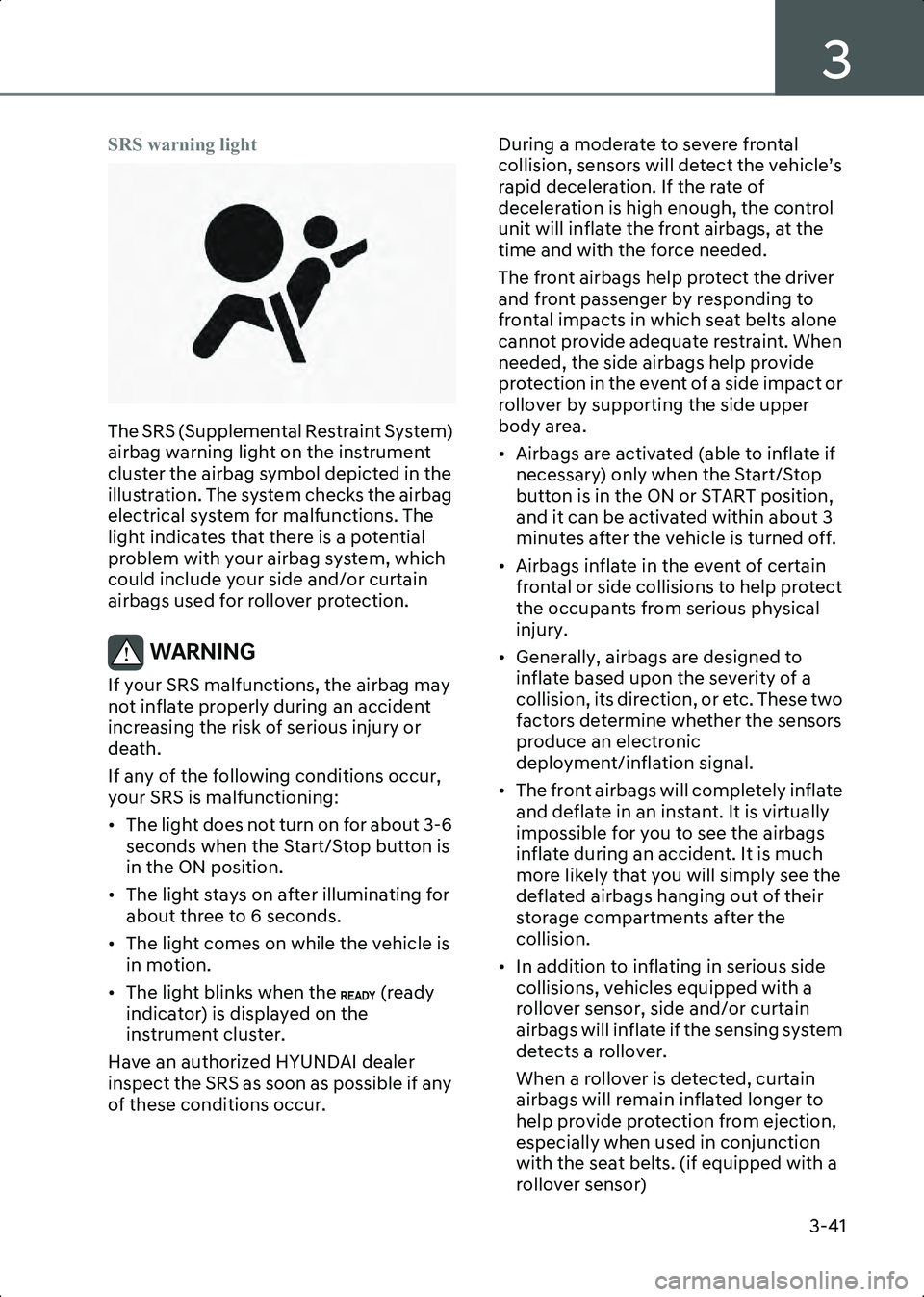
3
3-41
SRS warning light
B3002501
The SRS (Supplemental Restraint System)
airbag warning light on the instrument
cluster the airbag symbol depicted in the
illustration. The system checks the airbag
electrical system for malfunctions. The
light indicates that there is a potential
problem with your airbag system, which
could include your side and/or curtain
airbags used for rollover protection.
WARNING If your SRS malfunctions, the airbag may
not inflate properly during an accident
increasing the risk of serious injury or
death.
If any of the following conditions occur,
your SRS is malfunctioning:
• The light does not turn on for about 3-6 seconds when the Start/Stop button is
in the ON position.
• The light stays on after illuminating for about three to 6 seconds.
• The light comes on while the vehicle is in motion.
• The light blinks when the (ready indicator) is displayed on the
instrument cluster.
Have an authorized HYUNDAI dealer
inspect the SRS as soon as possible if any
of these conditions occur.
During a moderate to severe frontal
collision, sensors will detect the vehicle’s
rapid deceleration. If the rate of
deceleration is high enough, the control
unit will inflate the front airbags, at the
time and with the force needed.
The front airbags help protect the driver
and front passenger by responding to
frontal impacts in which seat belts alone
cannot provide adequate restraint. When
needed, the side airbags help provide
protection in the event of a side impact or
rollover by supporting the side upper
body area.
• Airbags are activated (able to inflate if
necessary) only when the Start/Stop
button is in the ON or START position,
and it can be activated within about 3
minutes after the vehicle is turned off.
• Airbags inflate in the event of certain frontal or side collisions to help protect
the occupants from serious physical
injury.
• Generally, airbags are designed to inflate based upon the severity of a
collision, its direction, or etc. These two
factors determine whether the sensors
produce an electronic
deployment/inflation signal.
• The front airbags will completely inflate and deflate in an instant. It is virtually
impossible for you to see the airbags
inflate during an accident. It is much
more likely that you will simply see the
deflated airbags hanging out of their
storage compartments after the
collision.
• In addition to inflating in serious side collisions, vehicles equipped with a
rollover sensor, side and/or curtain
airbags will inflate if the sensing system
detects a rollover.
When a rollover is detected, curtain
airbags will remain inflated longer to
help provide protection from ejection,
especially when used in conjunction
with the seat belts. (if equipped with a
rollover sensor)
Hyundai_CE_en_US.book Page 41
Page 138 of 582
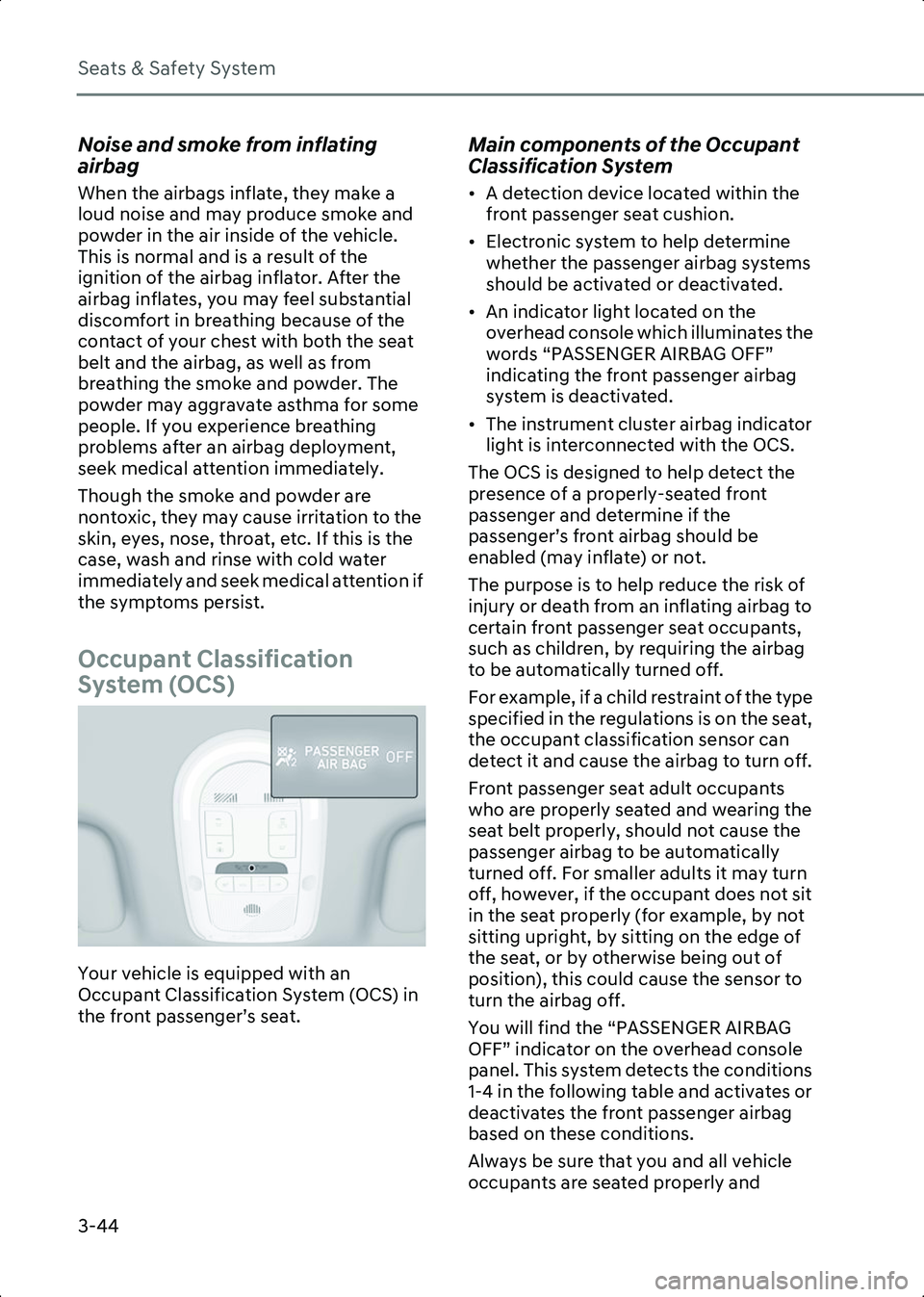
Seats & Safety System
3-44
Noise and smoke from inflating
airbag
When the airbags inflate, they make a
loud noise and may produce smoke and
powder in the air inside of the vehicle.
This is normal and is a result of the
ignition of the airbag inflator. After the
airbag inflates, you may feel substantial
discomfort in breathing because of the
contact of your chest with both the seat
belt and the airbag, as well as from
breathing the smoke and powder. The
powder may aggravate asthma for some
people. If you experience breathing
problems after an airbag deployment,
seek medical attention immediately.
Though the smoke and powder are
nontoxic, they may cause irritation to the
skin, eyes, nose, throat, etc. If this is the
case, wash and rinse with cold water
immediately and seek medical attention if
the symptoms persist.
Occupant Classification
System (OCS)
B3003102
Your vehicle is equipped with an
Occupant Classification System (OCS) in
the front passenger’s seat.
Main components of the Occupant
Classification System
• A detection device located within the front passenger seat cushion.
• Electronic system to help determine whether the passenger airbag systems
should be activated or deactivated.
• An indicator light located on the overhead console which illuminates the
words “PASSENGER AIRBAG OFF”
indicating the front passenger airbag
system is deactivated.
• The instrument cluster airbag indicator light is interconnected with the OCS.
The OCS is designed to help detect the
presence of a properly-seated front
passenger and determine if the
passenger’s front airbag should be
enabled (may inflate) or not.
The purpose is to help reduce the risk of
injury or death from an inflating airbag to
certain front passenger seat occupants,
such as children, by requiring the airbag
to be automatically turned off.
For example, if a child restraint of the type
specified in the regulations is on the seat,
the occupant classification sensor can
detect it and cause the airbag to turn off.
Front passenger seat adult occupants
who are properly seated and wearing the
seat belt properly, should not cause the
passenger airbag to be automatically
turned off. For smaller adults it may turn
off, however, if the occupant does not sit
in the seat properly (for example, by not
sitting upright, by sitting on the edge of
the seat, or by otherwise being out of
position), this could cause the sensor to
turn the airbag off.
You will find the “PASSENGER AIRBAG
OFF” indicator on the overhead console
panel. This system detects the conditions
1-4 in the following table and activates or
deactivates the front passenger airbag
based on these conditions.
Always be sure that you and all vehicle
occupants are seated properly and
Hyundai_CE_en_US.book Page 44